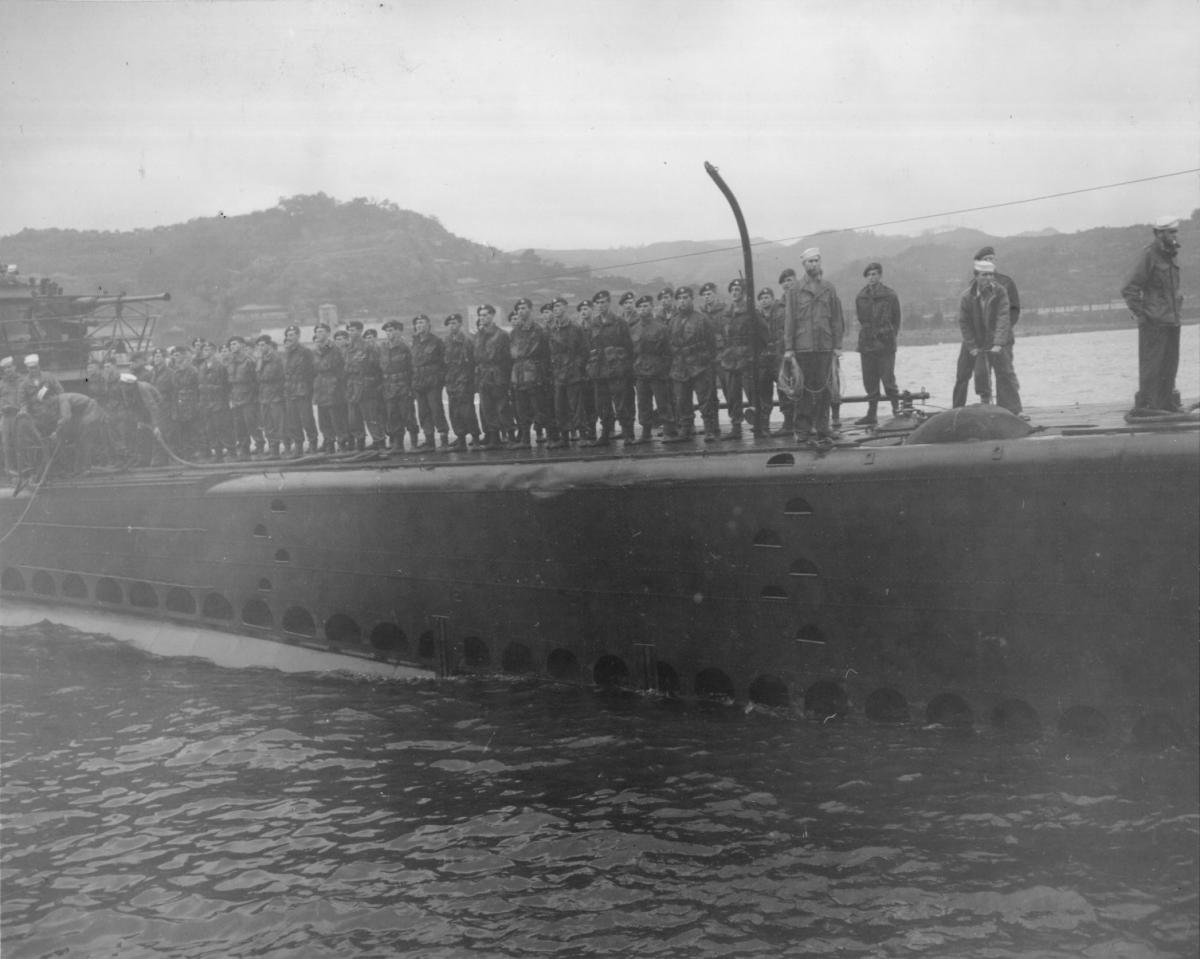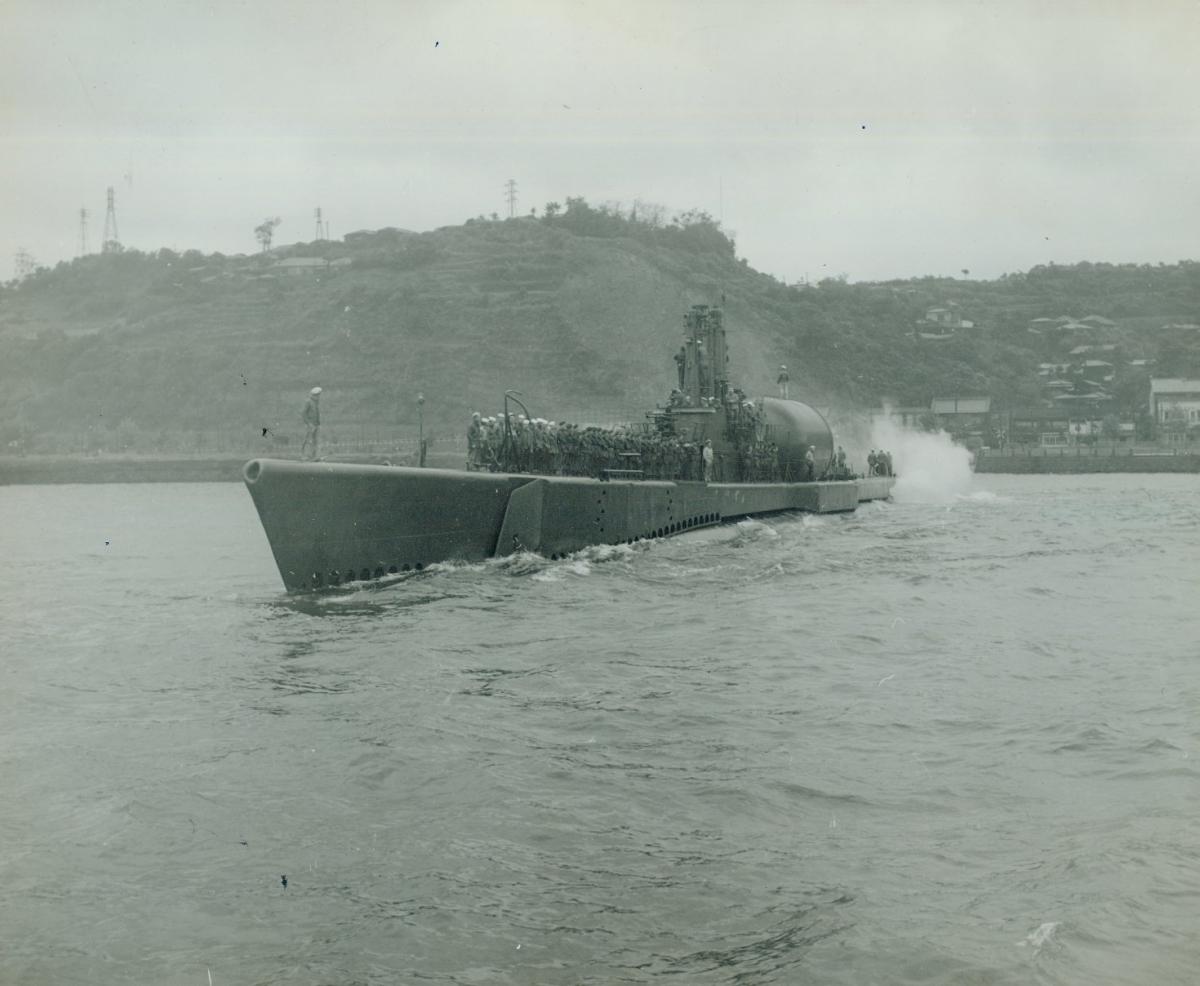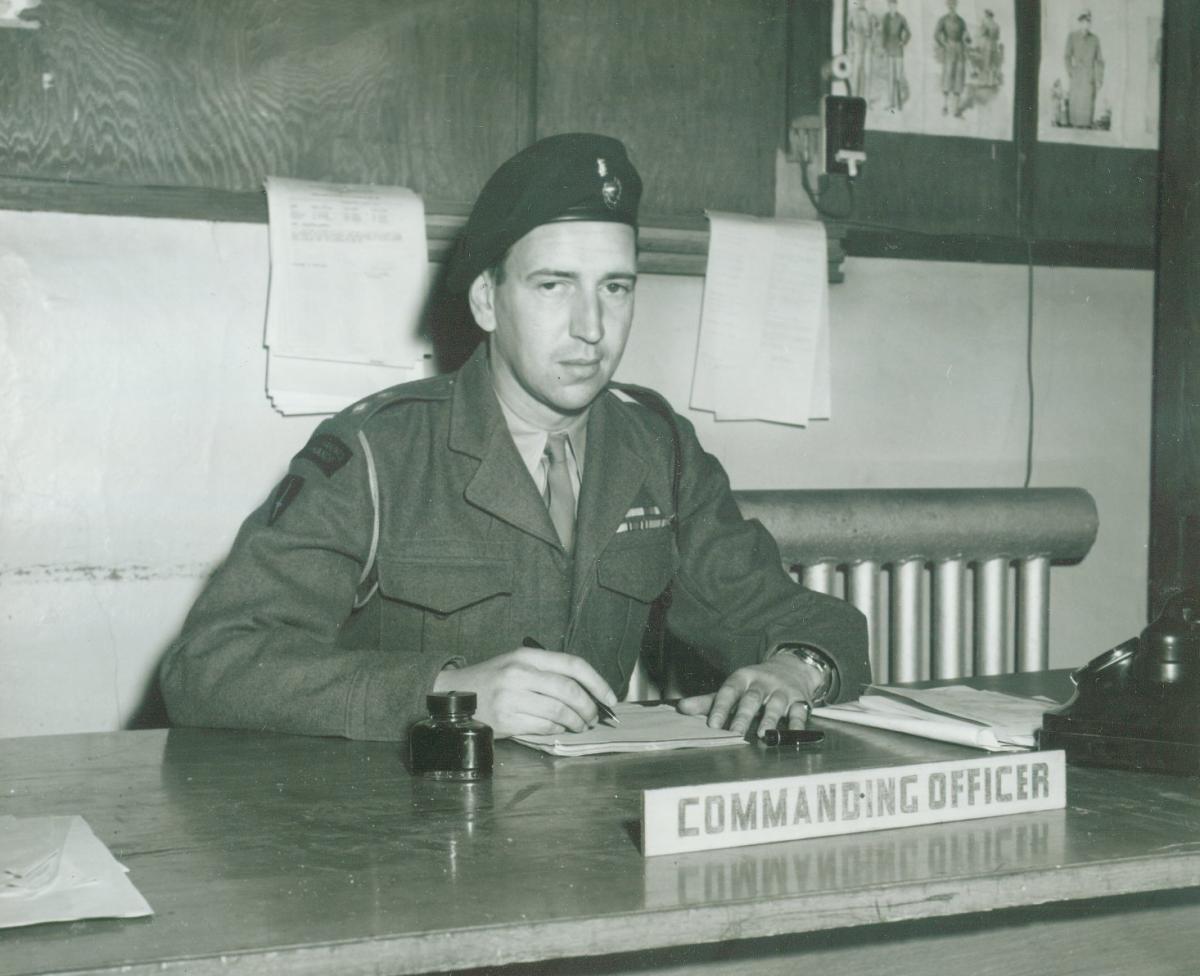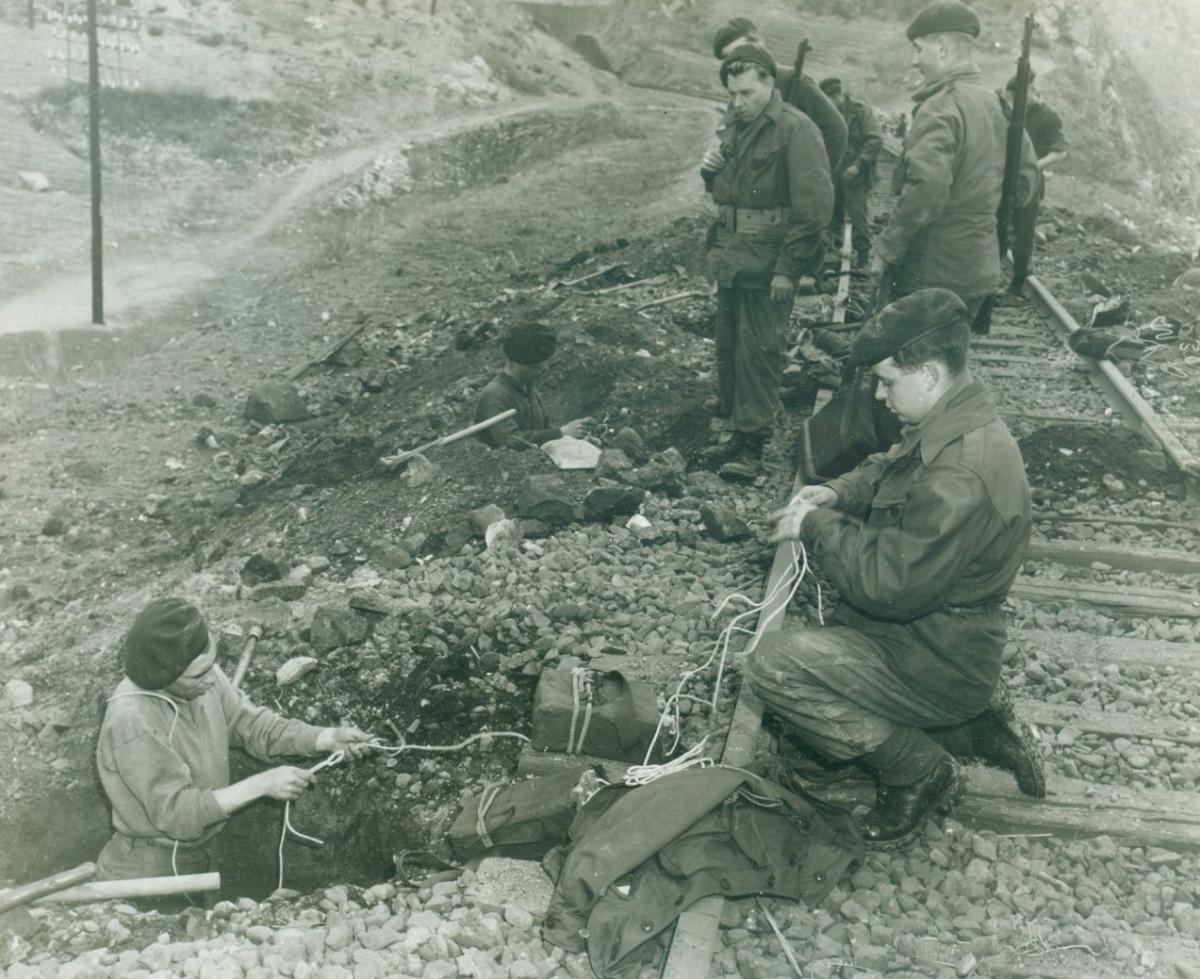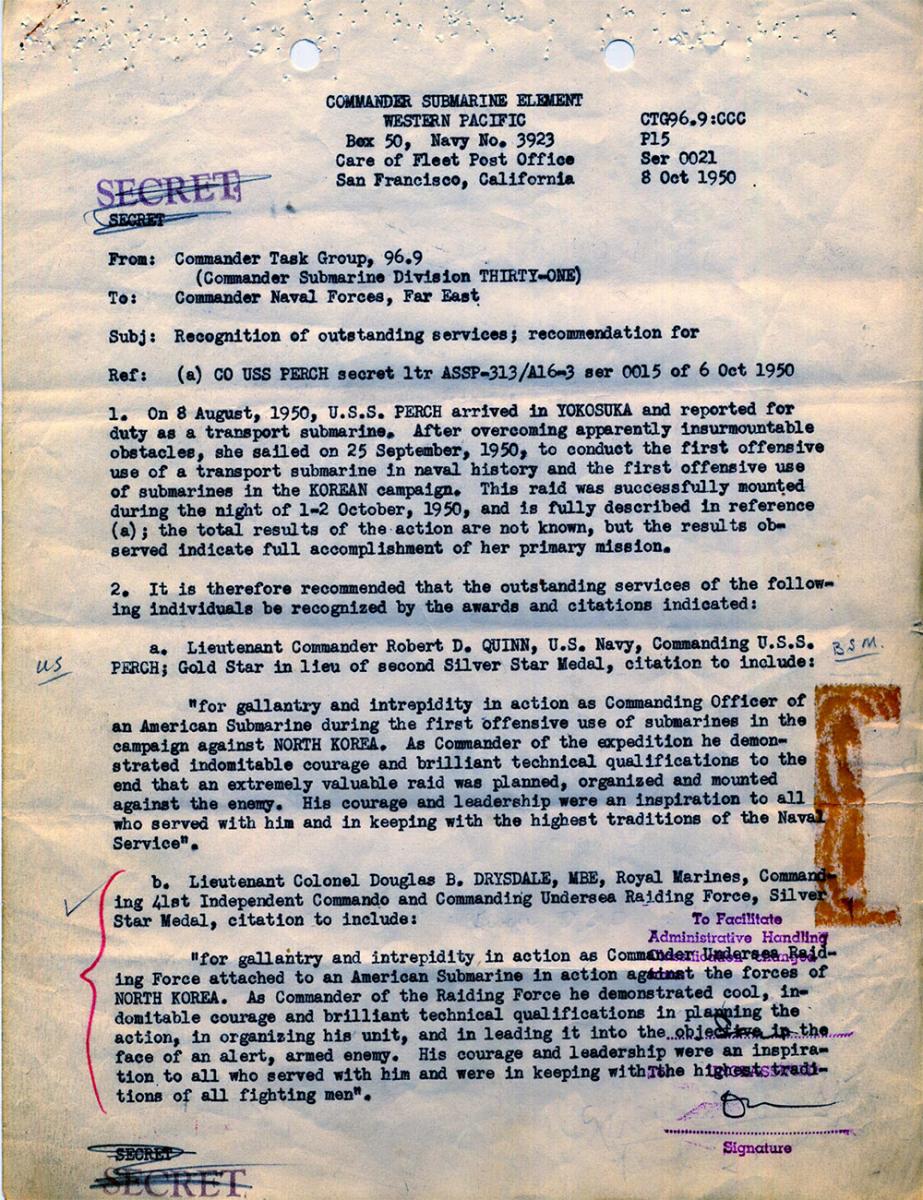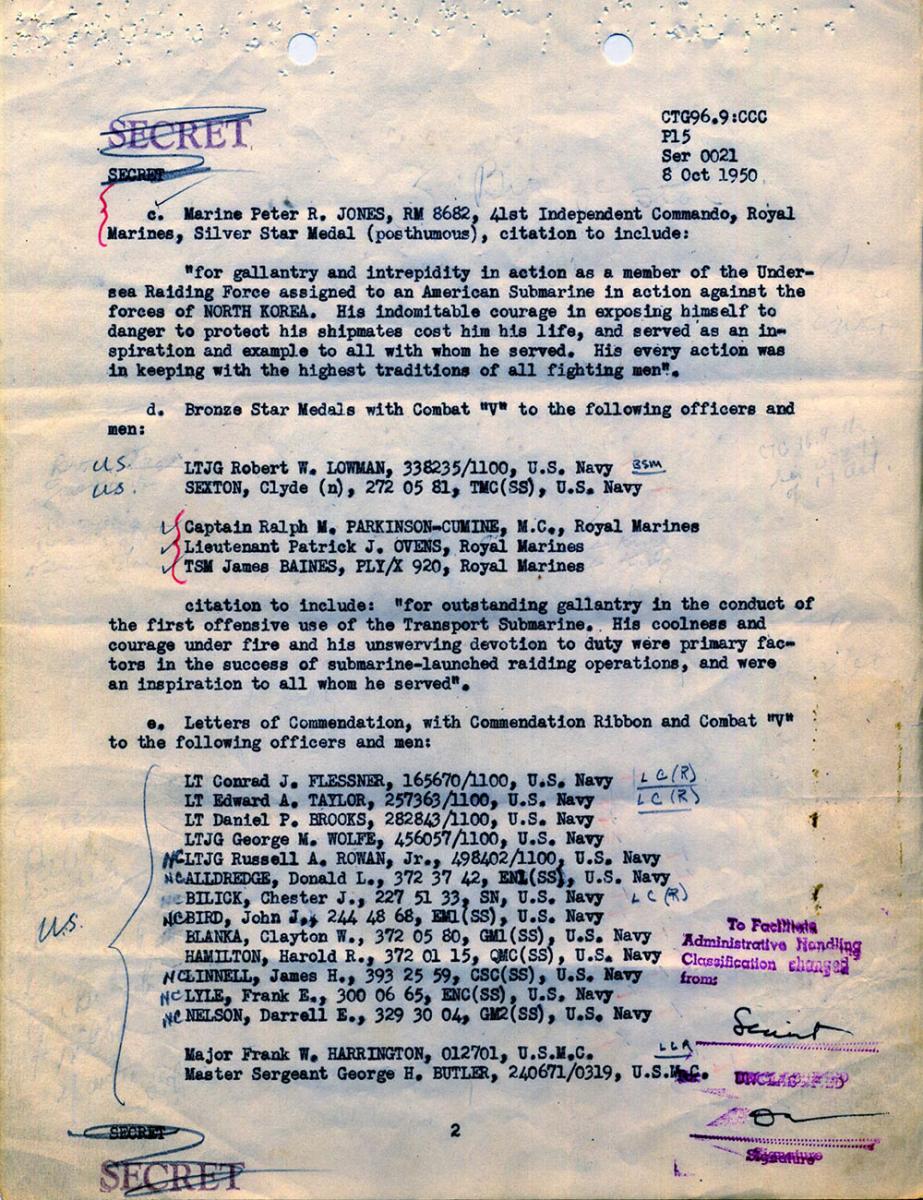
Silently. Quickly. By Sea, in Darkness.
How U.S. Submarines Helped Special Troops Destroy Enemy Supply Lines in the Korean War
Winter 2016, Vol. 48, No. 4
By Nathaniel Patch
As the American submarine USS Perch surfaced just off the east coast of North Korea, not far from the border with China, her crew and a detachment of Royal Marine commandos hurried on deck to open a large hangar.
Under the night sky on October 1, 1950, they began to inflate seven boats, six for commandos and Perch crewmen and one for high explosives and mines. At the same time, they also launched a 24-foot skimmer, a plywood boat with an outboard motor.
At just before 9 p.m., the skimmer set off toward the target area, which was a span of railroad tracks, bracketed by two tunnels that ran along the northeastern coast of North Korea, near the town of Shoko-Do (40° 22ʹ N and 128° 49ʹ). The plan was to set mines in the tunnels and to blow up the culvert on the open part of the track.
In a little more than an hour, the skimmer was within 500 yards of shore; two of the small boats took off in one direction to serve as lookouts for any North Korean troops, and four of them headed to the beach to put the explosives and mines in place. The men laying the explosives encountered a small group of North Koreans but drove them off.
The combat engineers first prepared pressure-triggered mines in the east and west tunnels. Then they retrieved the remaining high explosives that were left with the skimmer and began to work on placing them down a culvert in the mountainside. The resulting explosion in the culvert would cause a landslide, covering the rail tracks with rock and debris. When the North Koreans sent a repair train to clear the tracks, the pressure mines would detonate, blocking the tunnels and cutting off an important North Korean supply line. As the combat engineers were placing the explosives, small parties of North Koreans encroached upon them. The security patrols drove them off, but time was running out.
At around 12:30 a.m., as the work on the culvert was being completed, another party of North Koreans, possibly a group that had attacked before, tried to outflank the commandos. With all the charges set, the raiding party withdrew to the beaches with one of the groups under fire. Shortly after 1 a.m., they blew up the culvert, blocking the railroad tracks, then left the beach. The six boats rendezvoused at the skimmer.
Back on board the Perch, the Royal Marines reported a single casualty, Marine Peter Raymond Jones. He had been shot through the neck while the commandos were departing the beach. Later that day, Jones was buried at sea with a full honor guard firing three volleys. On the Perch, the United Nations flag was struck and lowered to half-mast.
This mission was the work of the crew of the USS Perch and the British 41st Independent Royal Marine Commandos and part of a strategy to repel the North Korean invasion of late June 1950 by cutting off their supply lines. This was one of a number of daring raids against North Korean railways conducted by the U.S. Navy with elite American and British special forces.
One, and only one, of these raids was launched from an American submarine, the USS Perch (ASSP 313), with her British commando guests, on the night of October 1, 1950.
The Perch’s First, and Last, Undersea Raiding Mission
Ironically, the USS Perch was notified shortly after the Royal Marines departed on this mission that this would be its first, and last, raiding mission. The discovery of mines along the eastern coast of North Korea prohibited any future missions of the Perch because she did not have any mine-detecting equipment.
The role of the British 41st Independent Royal Marine Commandos as an undersea raider was not a new concept. During World War II, Marines, soldiers, and an underwater demolition team (UDT) had been sent ashore from a submarine with mixed results.
In the Makin Raid in August 1942, a diversion for Guadalcanal landings, the 2nd Marine Raider Battalion was deployed from the USS Nautilus (SS 168) and USS Argonaut (SM 1) and successfully used to deliver armed troops behind enemy lines. But the mission was not without its difficulties in coordinating troops and submarines and with communication between the various units. Although the raid was successful, there were no other attempts of direct assaults during the war.
The next attempt brought elements of the 7th Army Scouts to the island of Attu in the Aleutian Islands in May 1943. The Nautilus and USS Narwhal (SS 167) landed 100 scouts at Scarlet Beach, several miles north of Massacre Bay, where the main landing force arrived. This operation was repeatedly postponed due to weather and the short time the submarines had to refresh their air during the Arctic spring nights. Again, this was a “one-off” mission.
The last mission was in August 1944, when the USS Burrfish (SS 312), while on a photo-reconnaissance mission, deployed a detachment of UDT swimmers to do beach reconnaissance on the islands of the Palau and Yap in the Caroline Islands in the Western Pacific. Because of simultaneous air strikes by the U.S. Army Air Force and the U.S. Navy, the Japanese were on constant alert, making the reconnaissance teams vulnerable to discovery. In the end, the three men of the UDT detachment were discovered and taken prisoner while they were surveying one of the beaches on Yap Island.
Undersea Raiding Required Changes in Design of Subs
During World War II, the concept of using a submarine to transport troops or elite forces covertly was never fully brought to fruition because there were some technical obstacles that needed to be overcome. Some of these obstacles included improvements in the environment aboard a submarine to accommodate 100 or more troops and storage space for all the equipment they would need.
The Navy’s desire to use the submarine to deploy Marine raiders, special forces, or light infantry continued into the Cold War. The proof of concept was there, but now it was time to refine the process with improved design and equipment and to increase safety for both the submarine and the away troops.
In February 1948 the USS Finback (SS 230) and the USS Grouper (SS 214) were on a simulated war patrol off the coast of Vieques, Puerto Rico. The Finback deployed members of the Troop Reconnaissance Company and a UDT to perform reconnaissance of beaches prior to landing a major force. The simulated patrol report praised the exercise and made a number of suggestions to improve the design of future transport submarines taking on this kind of mission.
The first suggestion, which dealt with inflatable boats used by landing troops, recommended that the boats be easy to access and to inflate and deflate. The report also advised that submarines cease their practice of remaining on the surface during the mission and instead surface only to launch troops, then submerge until the completion of the mission. This would minimize the detection of the submarine. The Finback may have hit a training mine during the exercise, sending up a flare, so the report recommended that future transport submarines be equipped with mine-detecting equipment.
Between the end of World War II in 1945 and the outbreak of the Korean War in 1950, the U.S. Navy modified several “fleet” submarines to fulfill several different, very specific missions, including a fleet oiler (SSO), a picket-RADAR submarine (SSR), a guided-missile submarine (SSG), and the troop transport (SSP). The Navy also used the innovations for submarines that the Germans and the Japanese had developed during World War II, such as the snorkel, high-capacity batteries, and a more hydrodynamic hull reconfiguration.
Not all submarines received all of the modifications, and depending on their mission, some modifications were preferred over others. In the case of the transport submarine, the USS Perch and the USS Sealion (ASSP 315) only had snorkels installed because the other modifications, such as additional batteries, took up space that was needed for the additional troops. To make more room for troops, the forward and aft torpedo rooms and the forward engine room were removed for berthing space. The transport submarines had their outer hull more streamlined, the deck guns were removed, and a distinctive 48-foot, water-tight hangar was placed aft of the sail to store large equipment such as an amphibious tractor (LVT), a number of inflatable rubber boats, or a large outboard boat.
The submarine transport and her equipment were only one half of the equation. The other half was the raiding party. The Navy waffled between using a Marine unit and an underwater demolition team (UDT). Although the Marine reconnaissance company and UDTs were considered equally suitable for submarine duty, the Navy began to train the crew of the Perch with a detachment of Marines before the outbreak of the Korean War.
Early Action in Korea Hold Off North’s Army
North Korea’s invasion of South Korea in June 1950 took the world by surprise—there was a real concern that the invasion was a prelude to a wider war both in the Far East and possibly Europe.
The American forces already in the Far East had to hold off the North Koreans until reinforcements could arrive. The Korean War showed the United States that future conflicts would be regional instead of global but would still need to be contested with conventional weapons, using proven warfare doctrine, and fought with assistance from coalition allies rather than using nuclear weapons.
One of the chief advantages that the United States and the United Nations Forces had was control of the sea. The North Koreans did not have a navy that could oppose the U.S. Navy, so the United States and the allies could move troops and supplies around the Korean peninsula unchallenged. The U.S. Navy seized this advantage to resupply and reinforce the Pusan Perimeter from Japan, conduct amphibious landings at Inchon and later Wonsan, and conduct raids along the coasts of areas controlled by North Korea.
The North Koreans’ reliance on railroads to move troops and supplies made the rail lines a vulnerability. The Korean peninsula’s mountainous terrain forces rail lines out to the coastlines, through tunnels, and next to tall hills and mountains.
How best could the allies exploit this Achilles’ heel?
The lightening-quick invasion from the north pushed the American and South Korean forces down to the southeast portion of the peninsula around the city of the Pusan. To attack the North Korean supply lines, American aircraft carriers from the Seventh Fleet flew sorties to bomb roads, bridges, and railway lines, and cruisers and destroyers shelled transportation corridors.
The problem was that the United States had not yet developed precision weapons like cruise missiles, and bombs and shells were too inaccurate or required a large amount of ordnance to achieve the mission.
USS Juneau Performs Raid Close to the Target Area
The solution to the problem of accurately and efficiently attacking North Korean railways nestled in the coastline mountains came from the executive officer of the USS Juneau (CL 119), Commander W. B. Porter. On the night of July 11, 1950, Porter, a demolition expert, and eight other crewmen attacked the east coast rail lines in the area of Rashin.
Porter and his men transferred to the USS Mansfield (DD 728), which took them within two miles of the coast of the target area. Using a whaleboat, the 10 men, armed with charges, detonators, carbines, maps, compasses, and walkie-talkie radios, paddled ashore. The group placed the demolition charges in a train tunnel, which blew up a train after the party departed.
The success of this raid gave genesis to the Special Operations Group (SOG) on August 6, 1950, which was tasked with the mission to continue such demolition raids against North Korean rail lines. The SOG used the First Marine Reconnaissance Company and Underwater Demolition Team One from surface vessels called fast-transports (APDs) to conduct similar missions. On August 8, 1950, the USS Perch arrived in Yokosuka, Japan, to participate in these special demolition operations. Upon arrival, the crew of the Perch learned that their detachment of Marines was being reassigned to their regiment at the Pusan Perimeter. This left a transport submarine without anyone to transport.
The Navy attempted to find a suitable replacement for the Marines who had trained on the Perch. First, they assigned a detachment from UDT 1. After a short training period, the two groups synched and were ready for their first mission against the North Koreans. But UDT 1 was assigned to another mission and flown to Korea. The next two candidates were two Army special activities companies. Lt. Comdr. Robert Quinn, the commander of the Perch, had a lukewarm opinion of them: “They came to us recommended as real ‘hot shots’. They were not as inspired or as well trained as the UDT’s or U.S. Marines but by the end of the week they were fairly proficient in debarking from Perch.”
But as with UDT 1, the two Army units were reassigned to other missions. At the end of August, 17 British volunteer raiders were invited aboard for a one-day demonstration. They conducted a few disembarking drills and were shown the submarine and outboard boats. On September 18, the 67-man unit of the 41st Independent Royal Marine Commandos reported aboard at Camp McGill, Japan.
British Commandos Learn American Ways
The 41st Independent Royal Marine Commandos, a 300-man British brigade size unit, was an unusual group, and the use of “Independent” in the name denotes the haste in which the unit was formed. The new unit of Royal Marines was composed of three groups: volunteers and reservists in the United Kingdom, volunteers from the sailors and Marines from the British Pacific fleet, and reinforcements bound for Malaysia to combat the communist insurgency in the Malayan Emergency. The first group that was organized in England was flown to Japan dressed in civilian clothes to disguise their true purpose.
The Marine commandos were placed under the operational control of the U.S. Navy and were assigned to report to Camp McGill, Japan, for training with the Perch. The commander of the new commando unit was Lt. Col. Douglas B. Drysdale, a seasoned officer in the Royal Marines and a veteran of World War II, having served as a commando in the Far East.
In addition to training on how to embark and disembark from the Perch, the Marine commandos had to become familiar with American small arms and equipment. It was agreed between the British and the Americans that the commandos should use the same weapons being used by the U.S. Marines and U.S. Army. The commandos also learned to use the standard American issue SCR 536 short-range radio (an oversized handset with a pull-out antenna) and the SCR 300 net set radio. Lt. Commander Quinn was impressed with the commandos’ “can do” attitude and their quick adaptation to American equipment and to life aboard a submarine.
The 41st Commandos and the Perch went on several amphibious landing exercises during the one-week training period, which included a full-scale simulated demolition raid.
The Royal Marines and the crew of the Perch appeared to get along. The commandos remarked on the quality of submarine food, stating that “one of the steaks is a week’s meat ration in England.” Typically the commandos averaged about six eggs for breakfast. While ashore on liberty after the full-scale exercise, the crew of the Perch were made honorary members of the Chowder, Marching, Singing and Shakespeare Society, celebrating through the streets around Camp McGill until 1:30 a.m., which inspired a few “conversations” at the officers club.
Before the training got under way and even before the Royal Marines arrived, the particulars of the mission for the undersea raiding force had to be determined. In July 1950, top commanders established several joint target zones along the east coast of North Korea where there were vulnerable railroad lines that were a direct conduit from the Soviet Union to North Korea. To plan out the raids, Far East Command sent the USS Pickerel (SS 524) to photograph prospective sites in August. From that photoreconnaissance mission, four target sites were prioritized in the Perch’s operational plan.
Perch, British Commandos Scrub a First Attempt
The mission parameters listed four targets that the undersea raiders were to attack during their patrol. The Perch was to first conduct a reconnaissance of the target areas and, working with Drysdale, determine the best means to deploy the commandos against the desired objectives.
On September 25, the Perch and her undersea raiding force set sail toward her patrol area. On the night of September 30, the Perch arrived at the first target area, and the commandos prepared to make their first demolition raid.
The previous day, Quinn had received a dispatch warning that there could be mines and not to go beyond the 50-fathom curve. That meant the submarine had to stay offshore about four miles, or where the depth was about 50 fathoms or deeper, where there was less likelihood of sea mines. In the morning they inspected their target area, a railroad bridge. The smoke of a passing train was seen as a good sign.
The Perch stationed herself more than four and a half miles off the shore, and just before seven in the evening, the submarine surfaced and the crew began to prepare for that night’s raid. The crew inflated the seven rubber boats, and at 7:30 the Perch lowered her aft end to launch the skimmer from the hangar section.
This was where the problems began.
The skimmer’s outboard motor would not start. The engine apparently got flooded and failed to turn over.
While the maintenance crew worked on the skimmer, the officers on the bridge observed the landing area. First, an enemy patrol boat transited the landing area. Then lights appeared at either end of the bridge, and then suddenly they went out. Two trucks appeared on the beach of the landing area. Soon after the lights of the trucks went out, a myriad of smaller lights went out across the beach all at the same time. Quinn determined that the North Koreans had picked them up on radar after surfacing and set up a trap.
He called off the raid, and crew and commandos packed everything back up. It was fortuitous that the skimmer’s engine failed that night because the commandos would have landed right in the middle of a well-laid ambush.
After getting the equipment stowed away, Quinn, Drysdale, and their officers began to consider their options for the next target the following night. The new plan included two destroyers, with one going south to create a diversion while the other stayed with the Perch to provide cover fire for the landing force if needed.
On the night of October 1, the Perch chose a second target, a few miles north and east of the previous night’s landing area. At 7:30 p.m., the USS Herbert J. Thomas began a diversionary mission and was ready to attack any patrol craft coming out of Shoko-Do. The Perch and the USS Maddox proceeded to their position off of the landing area. The Maddox, which was 4,000 yards to the west of the Perch, was to fire only if the landing got into trouble.
At 7:45 p.m., before surfacing, the Perch spotted a patrol boat through the periscope responding to the diversion created by the Herbert J. Thomas. The diversion appeared to be successful, and the new landing area was clear. The submarine surfaced and got the undersea raiding force off to their one and only demolition raid from the Perch. As the commandos set about their work on shore, Quinn and the crew of the Perch, listening to activity ashore over the radio, felt the tension rise, and those on the bridge of the submarine could see sporadic gun flashes and roving lights. In his description in the patrol report, Quinn remarked on his sense of powerlessness while gaining ever more respect for the Royal Marines.
When the commandos were retrieved at 2:39 a.m. on October 2, the raiders reported that the North Koreans were building pillboxes along the coast in this sector. The raids had had their effect, causing the North Koreans to divert men and material from the front to address the clandestine attacks from the sea. The Maddox reported hearing an additional explosion after the raiding force left the beach, and it was thought that one of the mines left in the tunnels had gone off.
USS Perch and the Commandos Return for New Assignments
With the cancellation of the attacks on the remaining targets, the destroyers sailed off to complete their sweeping patrol, and the Perch with her Royal Marines returned to Japan for new assignments. The British commandos continued to conduct raids until November 1950, when the weather turned too cold to conduct such raids, and United Nations Forces were pushing the North Koreans up toward the Yalu River. The commandos then played an important role in the tactical retreat at Chosin Reservoir and the evacuation at Hungham when the Chinese joined the fray in force in December 1950.
Lt. Colonel Drysdale and the others of the 41st Independent Royal Marine Commandos who served on the USS Perch were surprised that they had been so quickly recommended for awards. Quinn recommended several of the Royal Marines for medals and letters of commendation. Cyrus Cole, commander of Submarine Division 31, put forth a formal letter requesting that Drysdale and Marine Peter Jones be awarded the Silver Star. Several others received the Bronze Star with Combat “V,” and several more received letters of commendation. The Silver Star, along with the White Ensign that had covered his body, was presented to Marine Peter Jones’s mother.
The Perch, now without a mission, was recalled to Yokosuka, Japan, where the 41st Commandos and the Perch parted company. She would not be used again in this capacity during wartime until the Vietnam War in 1965. Commander Cole remarked in his endorsement of the Perch’s patrol report that the transport submarine was the “beginning of a new phase in submarine warfare . . . in which a submarine designed for a special purpose other than attack by torpedoes has been put to offensive use.”
Following the demolition raid by undersea raiders from the USS Perch, the Navy had to reevaluate the transport submarine concept and address the problems that occurred during the mission in Korea. The hazards of not having a mine detector on a transport submarine was identified in 1948 as a problem that jeopardized beach reconnaissance missions and clandestine raids. Two years later, the problem had still not been fixed. The experience of the Perch and the undersea raiders in Korea had shown how far out at sea a transport submarine had to go to achieve her mission and to avoid sea mines.
Another issue was enemy radar. On the night of September 30, the Perch had been discovered even though she was four miles out, and the North Koreans were able to quickly lay a trap for the raiders. The proliferation of radar technology since World War II was beginning to undermine the stealth of submarines and hamper surface-launched raiders. Finally, the “Undersea Raiding Force” itself was an issue. Since World War II and again in the Korean War, Adm. A. W. Radford, commander-in-chief of the Pacific Fleet, believed that the raiding force of a transport submarine should be part of the submarine crew. This innovation has never really taken hold, although today there are special units of U.S. Navy SEALs that specialize in submarine operations.
For their effort and being the first submarine to launch an attack against the enemy since World War II, the USS Perch and her crew were awarded the Submarine Combat Insignia. It award was one of only two such awards issued during the Korean War.
Nathaniel Patch is an archivist in the Reference Branch at the National Archives at College Park, Maryland, where he is on the Navy and Marine Corps Reference Team. He has a B.A. in history and an M.A. degree in naval history with an emphasis on submarine warfare.
Note on Sources
The story of the USS Perch and the Royal Marine Commandos in Korea first came to my attention when I was in graduate school working on a paper on amphibious warfare. True to my nature, I was unwilling to settle for the standard story of soldiers or Marines taking an opposed beach from landing craft.
In my research, I was surprised to learn that amphibious raiding had lived on beyond the 2nd Marine Raiders assaulting Makin Island in World War II and found that British commandos were being sent to attack railway lines in Korea from a submarine. The paper only touched the surface, so I wanted to expand it and develop a story to describe one of the few submarine operations during the Korean War.
The National Archives in College Park holds some recently accessioned and processed records relating to the U.S. Navy in the Korean War. One includes the post-1946 submarine patrol reports in Record Group 38, Records of the Chief of Naval Operations. The reports primarily relate to the immediate postwar period and the Korean War.
By coincidence, I discovered that the Finback and the Grouper had conducted a mission in the Caribbean, where a special unit was added. The report also suggested that future transport submarines should have mine-detecting equipment. This deficiency was the one that sent the Perch back to Japan after only one mission two years later.
The war patrols of the USS Perch and the USS Pickerel were also available and provided the context of the mission.
Also in Record Group 38 are the post-1946 war diaries of U.S. naval commands, which primarily cover the Korean War period.
Record Group 313, Records of the Naval Operating Forces, includes a number of recently processed records of Commander, Amphibious Forces, Pacific, and Commander, Submarine Forces, Pacific, that relate to the Korean War. Because the Undersea Raiding Force consisted of the British 41st Independent Royal Marine Commandos, and their report was included in the war patrol of the Perch, I sought added details from the Royal Marines Museum in Portsmouth, England. The Royal Marines Museum also has the White Ensign that had been placed over the body of Marine Peter Jones and later presented to his mother.
I would like to thank Amy Adams, George Malcolmson, and Alison Firth for their assistance in answering questions and making research materials available to my friend, Lawrence Lee, who took time out from a business trip to visit the museum on my behalf. I wanted the commandos to be well represented in this story, and to do so I felt it was necessary to get it from the source.
Although an American submarine and a British commando unit worked together only briefly, the concept of such missions was kept alive even though there is still a need for advances in technology to make the submarine safer in enemy waters and more hospitable to the crew and raiders.
